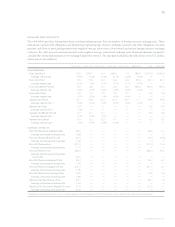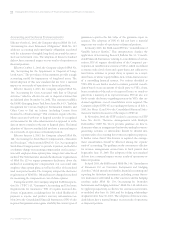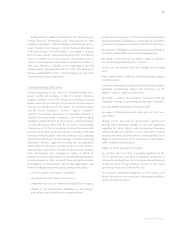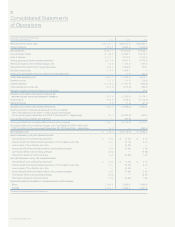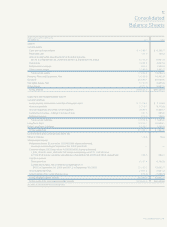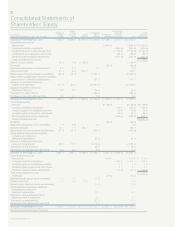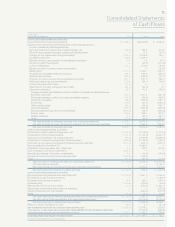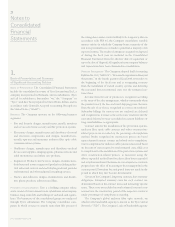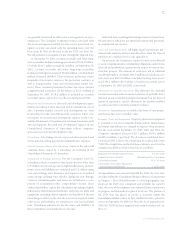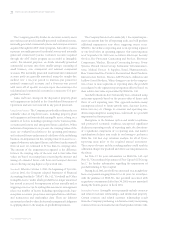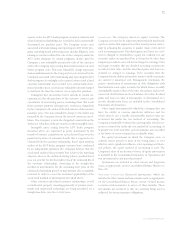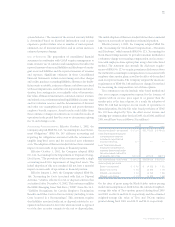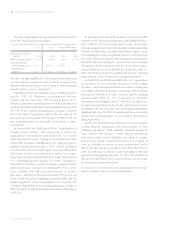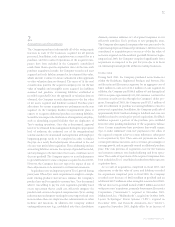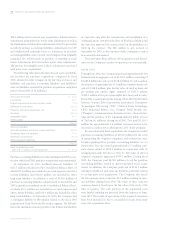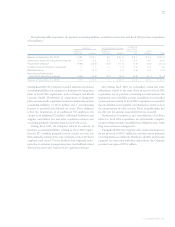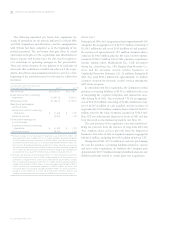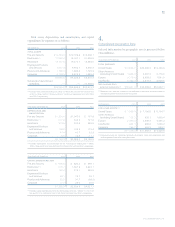ADT 2003 Annual Report Download - page 75
Download and view the complete annual report
Please find page 75 of the 2003 ADT annual report below. You can navigate through the pages in the report by either clicking on the pages listed below, or by using the keyword search tool below to find specific information within the annual report.
73
operate under the ADT dealer program. Acquired contracts and
related customer relationships are recorded at their contractually
determined net purchase price. The Company incurs costs
associated with maintaining and operating its ADT dealer pro-
gram, including brand advertising costs and due diligence costs
relating to contracts offered for sale to the Company under the
ADT dealer program. In certain programs, dealers paid the
Company a non-refundable amount for each of the contracts
sold to the Company representing their reimbursement of such
dealer program costs. This non-refundable charge represents
dealer reimbursement to the Company for costs incurred by the
Company associated with maintaining and operating the ADT
dealer program. Accordingly, each acquired contract and related
customer relationship was recorded at its contractually deter-
mined purchase price, net of a non-refundable amount charged
to dealers at the time the contract was accepted for purchase.
During the first six months (twelve months in certain cir-
cumstances) after the purchase of the customer contract, any
cancellation of monitoring service, including those that result
from customer payment delinquencies, results in a chargeback
by the Company to the dealer of the full amount of the contract
purchase price. The non-refundable charge to the dealer was
retained by the Company even in the event of customer cancel-
lation. The Company records the chargeback amount from the
dealer as a reduction of the previously recorded intangible asset.
Intangible assets arising from the ADT dealer program
described above are amortized in pools determined by the
month of contract acquisition on an accelerated basis over the
period and pattern of economic benefit that is expected to be
obtained from the customer relationship. Based upon attrition
studies of the ADT dealer program customer base, conducted
by an independent appraiser, the Company believes that the
accelerated method that presently best achieves the matching
objective above is the double-declining balance method based
on a ten-year life for the first eight years of the estimated life of
the customer relationship, converting to the straight-line
method of amortization for the remaining four years of the
estimated relationship period. Actual attrition data is regularly
reviewed in order to assess the continued applicability of the
accelerated method of amortization described above.
Other contracts and related customer relationships, as well
as intellectual property consisting primarily of patents, trade-
marks and unpatented technology, are being amortized on a
straight-line basis over five to forty years.
Investments The Company invests in equity securities. The
Company accounts for its long-term investments in marketable
equity securities that represent less than twenty percent owner-
ship by adjusting the securities to market value at the end of
each accounting period. Unrealized gains and losses are cred-
ited or charged to shareholders’ equity for available for sale
securities unless an unrealized loss is deemed to be other than
temporary, in which case such loss is charged to earnings. Debt
and equity securities that are classified as trading securities are
recorded at fair value, and the unrealized gains and losses are
credited or charged to earnings. Debt securities that the
Company has the ability and positive intent to hold to maturity
are carried at amortized cost. Management determines the
proper classification of investments in debt obligations with
fixed maturities and equity securities for which there is a readily
determinable market value at the time of purchase and reeval-
uates such classifications as of each balance sheet date. Realized
gains and losses on sales of investments, as determined on a
specific identification basis, are included in the Consolidated
Statements of Operations.
Other equity investments for which the Company does not
have the ability to exercise significant influence and for
which there is not a readily determinable market value are
accounted for under the cost method of accounting. The
Company periodically evaluates the carrying value of its invest-
ments accounted for under the cost method of accounting. At
September 30, 2003 and 2002, such investments were recorded
at the lower of cost or estimated net realizable value.
For equity investments in which the Company owns or
controls twenty percent or more of the voting shares, or over
which it exerts significant influence over operating and finan-
cial policies, the equity method of accounting is used. The
Company’s share of net income or losses of equity investments
is included in the Consolidated Statements of Operations and
was not material in any period presented.
Investments are included in other current and long-term
assets, as appropriate, on the Consolidated Balance Sheets (see
Note 28).
Restricted Investments Restricted investments, which are
included in other current and non-current assets, as appropriate,
on the Consolidated Balance Sheets, consist of fixed income
securities with maturities in excess of three months. These
investments are restricted as they are currently being used as
collateral for certain insurance obligations.
TYCO INTERNATIONAL LTD.


